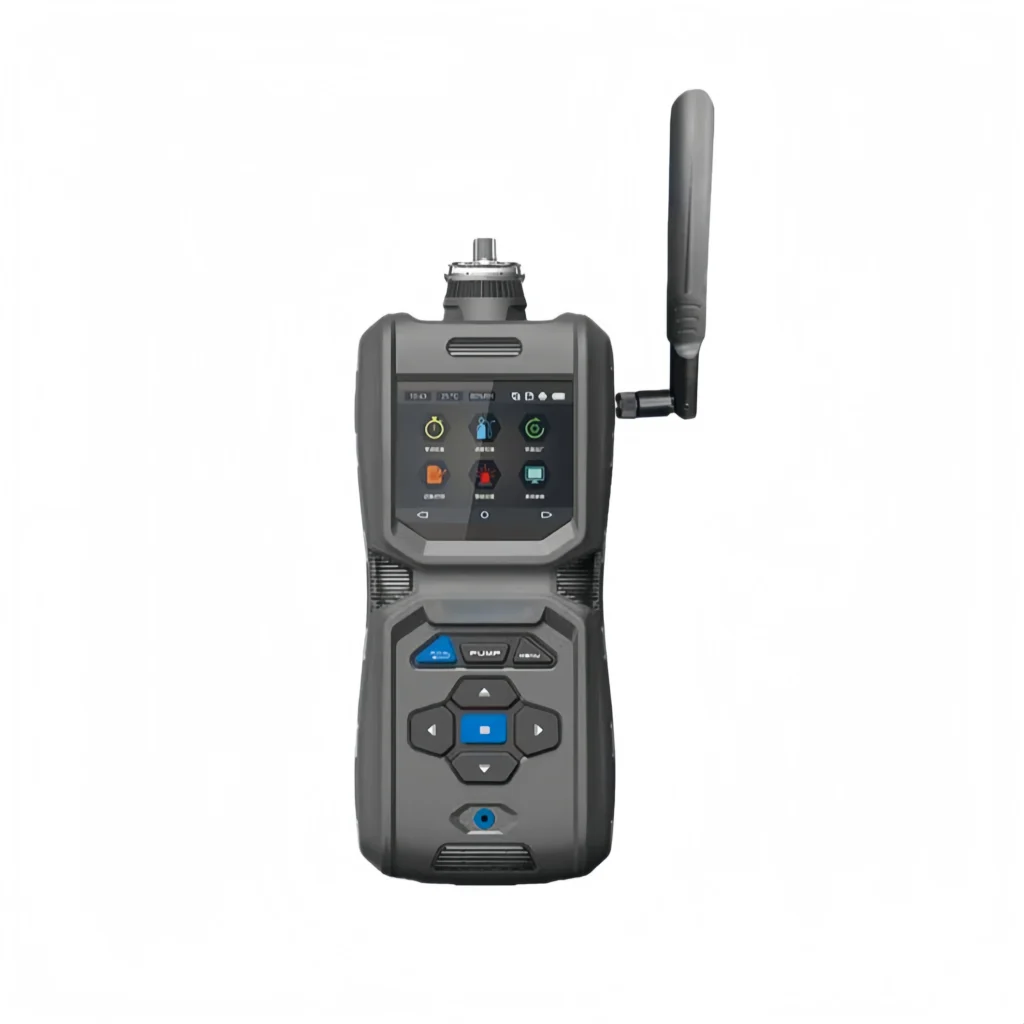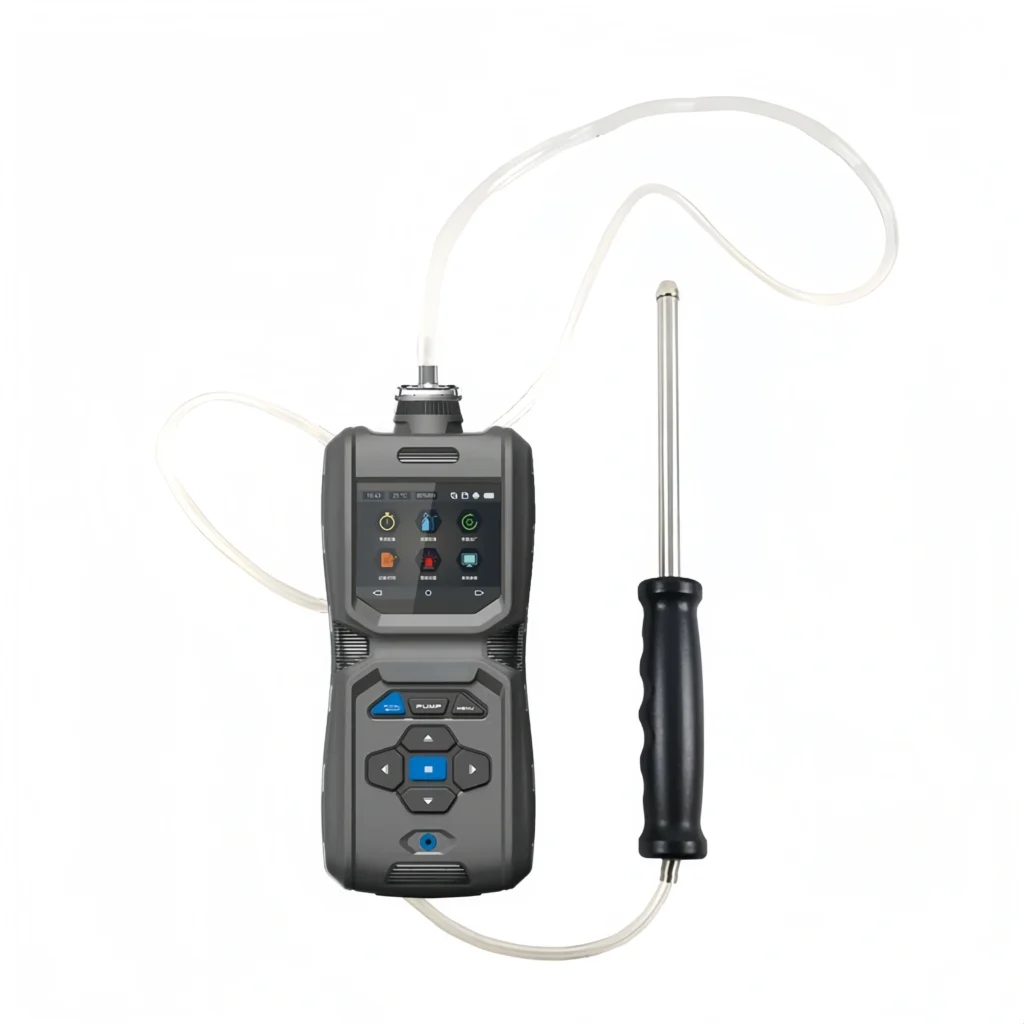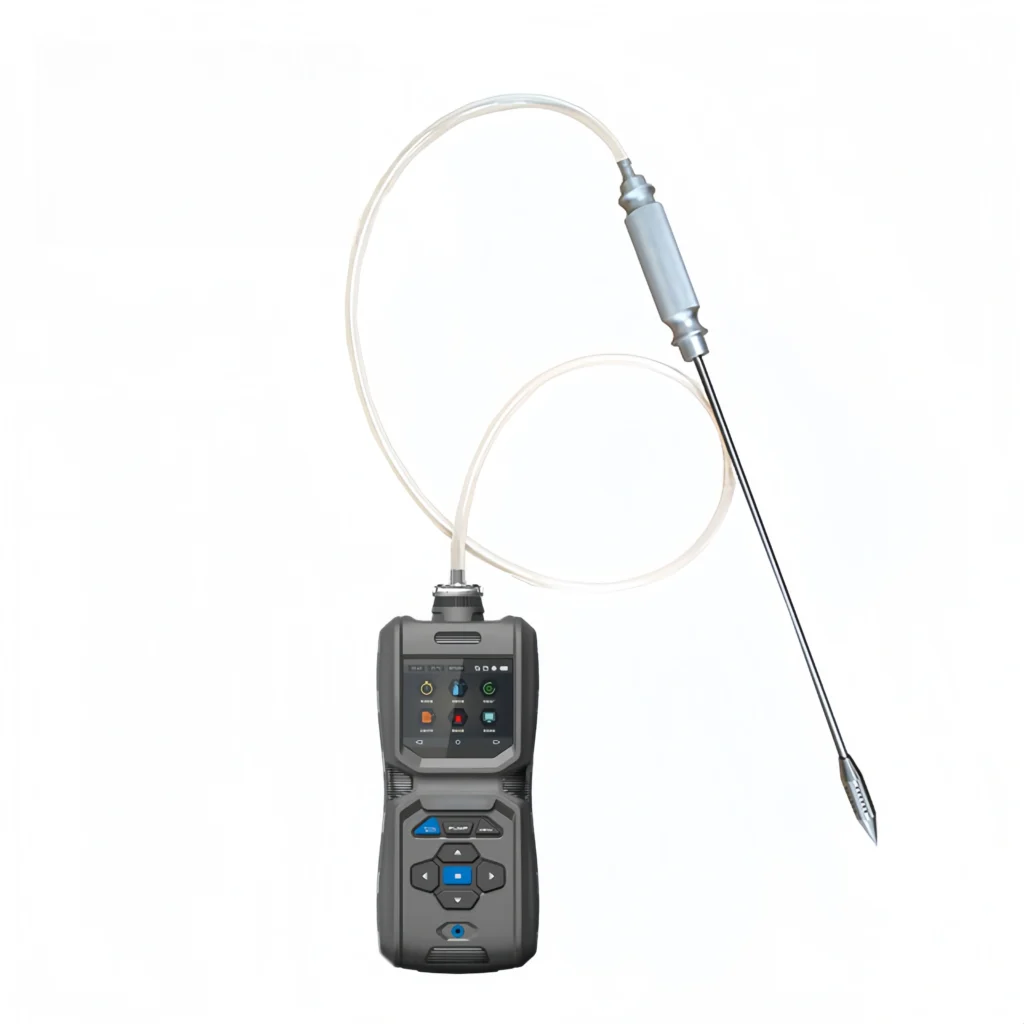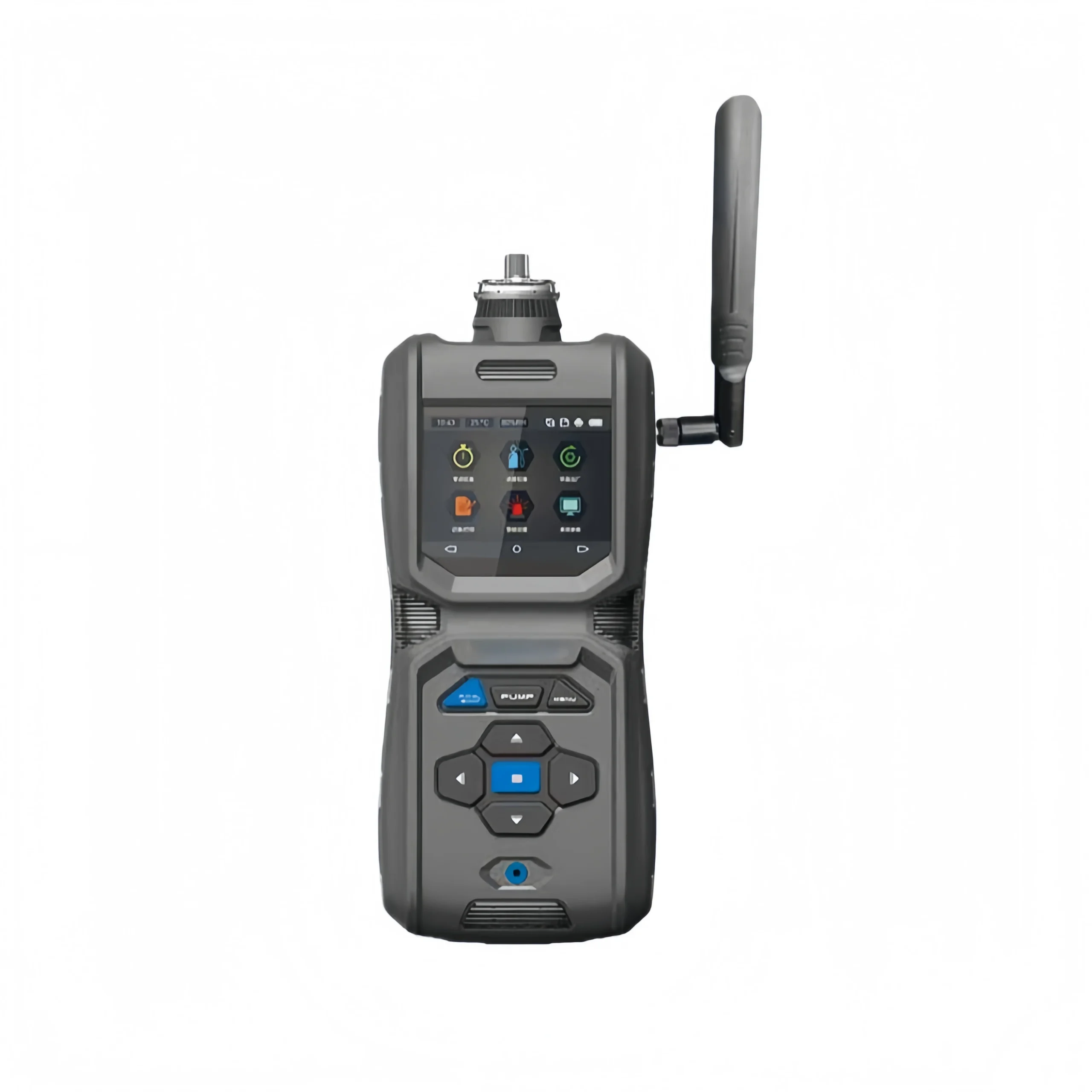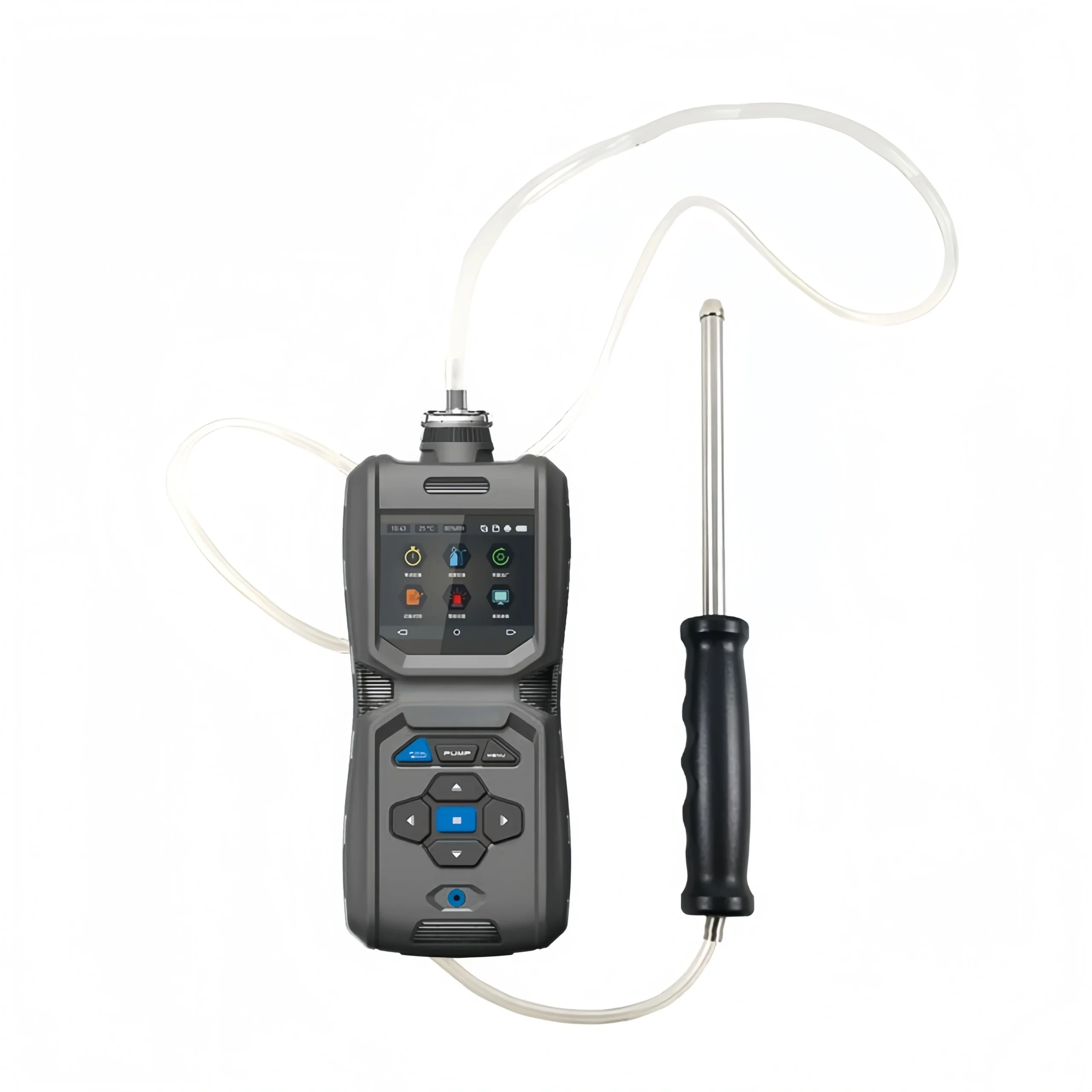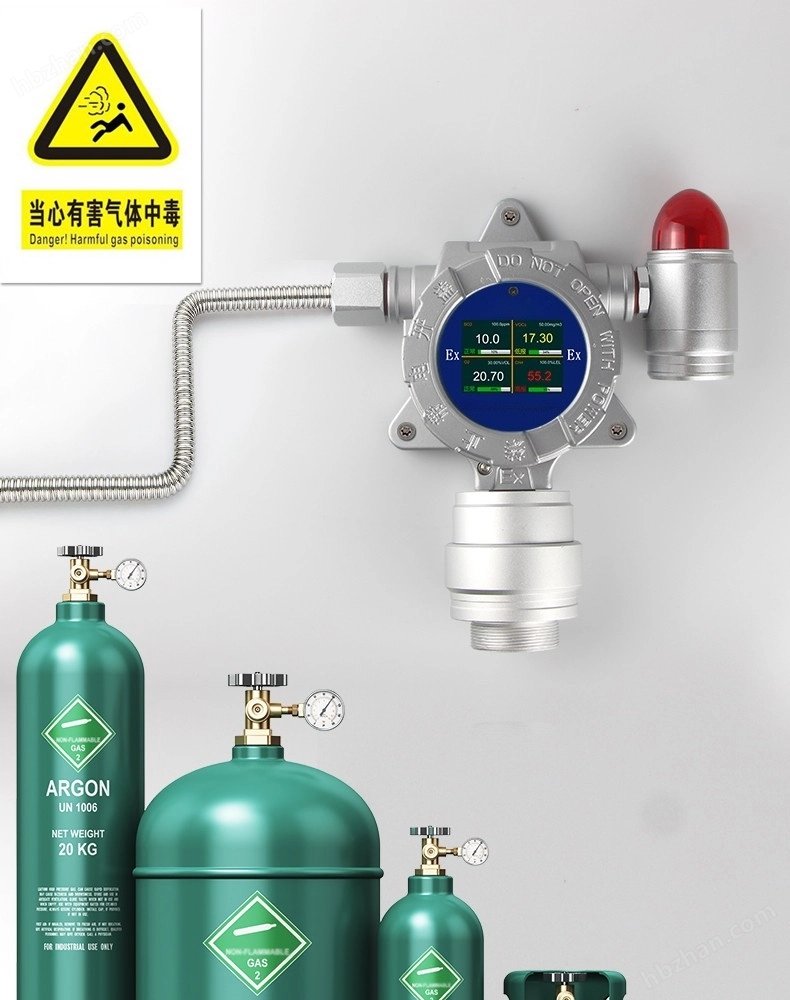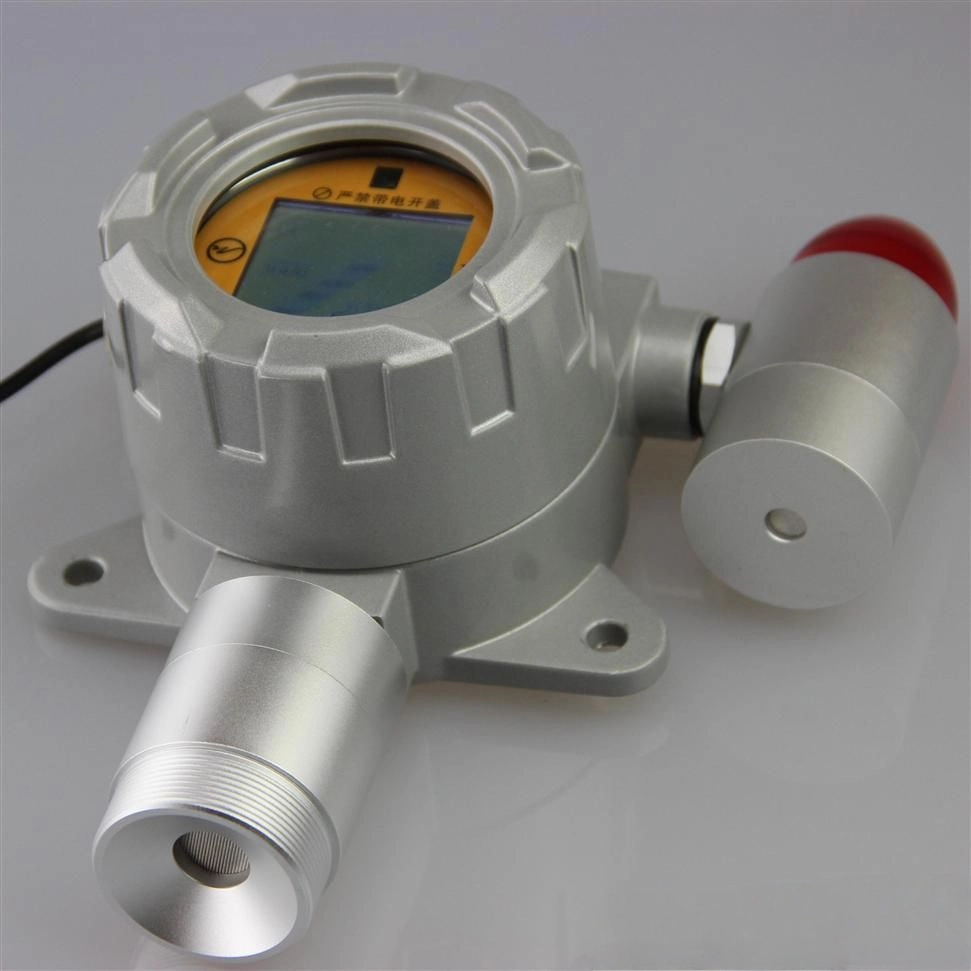The pump-suction type handheld VOC Monitor is a detection and alarm instrument for continuously monitoring the concentration of VOCs (volatile organic compounds). It can also be equipped with temperature and humidity measurement. It allows for convenient and rapid mobile detection of VOC concentrations in the air.
Suitable for detecting volatile organic compounds (VOCs) during the production and use of cleaning solvents, adhesives, coatings, paints, glues, organic solvents, inks, etc. When the detected VOC concentration reaches or exceeds the instrument’s preset alarm concentration value, the handheld VOC Monitor will emit an audible and visual alarm, vibrate, and display an alarm screen to alert the operator.
★★★★★
Features
★ Detects VOCs gases; up to 6 gases can be configured according to customer requirements. Units can be freely switched. Selectable units include: PPM, mg/m3, Vol%, LEL%, PPHM, ppb, mg/L.
★ Built-in pump-suction measurement. Integrated water vapor and dust filters. Rapid response, supports long-distance sampling.
- Built-in moisture and dust filters prevent sensor and instrument damage from moisture and dust, enabling operation in high-humidity and high-dust environments;
- Sampling distance exceeds 10 meters; specialized gas pathway design allows direct detection;
- Gas pressure ranging from negative to positive (-0.5 to 2 kg) has no impact on measurement results.
★The main detection principles of gas sensors include: electrochemical, infrared, catalytic combustion, thermal conductivity, and PID photoionization.
★Comprehensive Human-Machine Interface
A 2.5-inch high-definition color screen displays real-time concentration, alarm, time, temperature, humidity, storage, communication, printing, battery level, charging status, concentration unit, gas molecular formula, and gas name.
★Large-capacity data storage, supporting multiple storage methods
- Standard configuration includes 100,000 data storage capacity, with larger capacities available upon request;
- Supports real-time storage, scheduled storage, or storage of alarm concentration data only;
- Supports local data viewing and deletion;
- Data can also be uploaded to a computer via USB or RS232 interface for analysis, storage, and printing using host computer software.
★High-Temperature Gas Detection (Optional)
Optional high-temperature sampling and cooling filter handle or high-temperature and high-humidity pretreatment system can detect flue gas at temperatures up to 800 degrees Celsius. Higher temperature gas detection can be customized.
★Three Display Modes Switchable
Simultaneously displays five gas concentrations, with large font cyclic display of single-channel gas concentration, real-time curves, and historical curves.
★Graphical Display: Reflects the trend of gas concentration changes over a period of time in curve form.
★ Data Recovery Function
Partial or full data recovery is available, eliminating worries about data loss due to accidental operations.
★ Display of maximum, minimum, and average values can be set.
★ Standard USB charging with charging protection and USB hot-swapping support.
Chargeable with a computer or power bank, compatible with mobile phone chargers; overcharge, over-discharge, overvoltage, short circuit, and overheat protection; 5-level accurate power display; the instrument can operate normally while charging.
★ Uses a 6000mA high-capacity rechargeable polymer battery for extended continuous operation.
★ High-precision temperature and humidity measurement (optional) with sensor temperature compensation; operating temperature range -40 to 70 degrees Celsius.
★ Multiple alarm modes with multi-directional three-dimensional alarm status indication.
Includes audible and visual alarms, vibration alarms, and visual alarms on the display screen. Alarm types include: concentration alarm, undervoltage alarm, and fault alarm.
★ Multiple alarm mode settings: low alarm, high alarm, range alarm, and weighted average alarm.
★ Misoperation Detection Function
Automatically identifies and prevents misoperations during concentration calibration, avoiding errors caused by human factors.
★ Automatic Zero-Point Tracking: Unaffected by zero-point drift during long-term use.
★ Multi-Level Target Point Calibration: Ensures linearity and accuracy of measurements, meeting both national and local metrology standards.
★ Pump Switch: Allows for real-time or timed monitoring (for small gas volumes), and can shut down the pump to extend operating time.
★ Log Recording
Records calibration logs, maintenance logs, fault records, troubleshooting strategies, sensor lifespan expiration reminders, and reminders for the next concentration calibration.
★ Meets intrinsically safe circuit design requirements, anti-static, anti-electromagnetic interference, and has passed national standard testing and CMC metrology instrument production license certification.
★ IP67 protection rating: Waterproof, dustproof, explosion-proof, and shockproof.
Specifications
| Gas Detection | VOCs (Parameters can be customized; other gases can also be customized, see gas appendix) Optional: Can detect the concentration of any 1-6 gases and temperature/humidity. | |||||
| Range resolution | VOC: 0-100ppm, 0.01ppm, imported high-precision electrochemical sensor or VOC: 0-100%LEL, 0.1%LEL, industrial-grade catalytic combustion sensor or VOC: 0-10ppm, 0.01ppm, imported high-precision PID photoionization sensor Other ranges, principles, and resolutions can be customized. | |||||
| Detection method | Built-in pump suction, flow rate 500 ml/min; | |||||
| Display method | 2.5-inch 320*240 high-definition color screen display, 8-button operation; | |||||
| Detection accuracy | ≤±1%-3% (F.S) (Higher precision can be customized); | |||||
| Linearity | ≤±1%-3% | repeatability | ≤±1%-3% | |||
| Alarm method | Audible and visual alarm, vibration alarm, visual alarm, audible and visual alarm combined with vibration and visual alarm, and shutdown alarm. | |||||
| Response time | T90≤20 seconds | recovery time | ≤30 seconds | |||
| Operating power supply | DC3.7V | |||||
| Battery Capacity | 3.7VDC, 6000mA high-capacity rechargeable polymer battery | |||||
| Features overcharge, over-discharge, overvoltage, overheat, and short-circuit protection. | ||||||
| Operating environment: | Temperature -40℃ ~ +70℃; Relative humidity ≤0-99%RH (Built-in filter allows use in high humidity or high dust environments) | |||||
| Sample gas temperature | -40℃~+70℃ ; | |||||
| Optional high-temperature sampling and cooling filter handle or high-temperature and high-humidity pretreatment system can detect flue gas concentration from -40℃ to 1300℃. | ||||||
| Temperature measurement (optional) | -40~120℃, accuracy 0.5℃ | Humidity measurement (optional) | 0-100%RH, accuracy 3%RH | |||
| Data storage | Standard configuration includes 100,000 data entries; larger capacity is available upon request. Supports local viewing, deletion, and data export. Free host computer communication software is included. Storage function is off by default but can be enabled; storage interval is arbitrarily set. | |||||
| Communication interface | USB (charging and communication), RS232, infrared communication, automatic identification. | |||||
| Printer (optional) | External Mini Wireless Bluetooth Thermal Printer | |||||
| Interface language | Chinese or English can be set. | |||||
| Explosion-proof type | Intrinsically safe ExiaⅡCT4Ga | |||||
| Protection level | IP67, rain and splash resistant, dustproof | |||||
| Dimensions | 195×77×46mm (L×W×H) | Weight | 350g | |||
| Standard Accessories | Instruction manual, certificate of conformity, warranty card, USB charger (including data cable), alligator clip, lanyard, high-grade aluminum alloy instrument case; | |||||
| CD (host computer communication software), 1 humidity and dust filter. | ||||||
| Optional Accessories | 1.2 m retractable sampling handle (1-10 m hose, standard length 1 m), temperature and humidity measurement function | |||||
| CD (host computer communication software), lanyard, high-temperature sampling cooling filter handle, high-temperature and high-humidity pretreatment system; | ||||||
| Multiple humidity and dust filters, external mini wireless Bluetooth printer. | ||||||
| Applications | Suitable for spray painting, leather goods, petrochemical plants, printing, sewage/garbage treatment plants, gas station leaks, biomass, coal-fired power plants, semiconductor industries, metallurgical industries, and other similar applications. | |||||
Common Gases Appendix:
| Gases Detected | Measurement Range (Other measurement ranges are customizable) | Accuracy (Higher accuracy is customizable) | Resolution (Higher resolution is customizable) | Response Time |
| Combustible gas (EX) | 0-100%LEL | <±2%(F.S) | 0.1%LEL | ≤10 S |
| Combustible gas (EX) | 0-100%Vol | <±2%(F.S) | 0.1%Vol | ≤10 S |
| Methane (CH4) | 0-100%LEL | <±2%(F.S) | 0.1%LEL | ≤5 S |
| Methane (CH4) | 0-100%Vol | <±2%(F.S) | 0.1%Vol | ≤10 S |
| Oxygen (O2) | 0-30%Vol | <±2%(F.S) | 0.01%Vol | ≤15 S |
| Oxygen (O2) | 0-100%Vol | <±2%(F.S) | 0.01%Vol | ≤15 S |
| Oxygen (O2) | 0-1000ppm | <±2%(F.S) | 1ppm | ≤20 S |
| Oxygen (O2) | 0-50000ppm | <±2%(F.S) | 1ppm | ≤20 S |
| Carbon monoxide (CO) | 0-500ppm | <±2%(F.S) | 0.1ppm | ≤20 S |
| Carbon monoxide (CO) | 0-1000ppm | <±2%(F.S) | 0.1ppm | ≤20 S |
| Carbon monoxide (CO) | 0-2000ppm | <±2%(F.S) | 0.1ppm | ≤20 S |
| Carbon monoxide (CO) | 0-20000ppm | <±2%(F.S) | 1ppm | ≤20 S |
| Carbon monoxide (CO) | 0-100000ppm | <±2%(F.S) | 1ppm | ≤20 S |
| Carbon dioxide (CO₂) | 0-2000ppm | <±2%(F.S) | 1ppm | ≤20 S |
| Carbon dioxide (CO₂) | 0-5000ppm | <±2%(F.S) | 1ppm | ≤20 S |
| Carbon dioxide (CO₂) | 0-10000ppm | <±2%(F.S) | 1ppm | ≤20 S |
| Carbon dioxide (CO₂) | 0-50000ppm | <±2%(F.S) | 1ppm | ≤20 S |
| Carbon dioxide (CO₂) | 0-20%Vol | <±2%(F.S) | 0.01%Vol | ≤20 S |
| Carbon dioxide (CO₂) | 0-50%Vol | <±2%(F.S) | 0.01%Vol | ≤20 S |
| Carbon dioxide (CO₂) | 0-100%Vol | <±2%(F.S) | 0.01%Vol | ≤20 S |
| Formaldehyde (CH₂O) | 0-10ppm | <±2%(F.S) | 0.001ppm | ≤20 S |
| Formaldehyde (CH₂O) | 0-50ppm | <±2%(F.S) | 0.01ppm | ≤20 S |
| Formaldehyde (CH₂O) | 0-1000ppm | <±2%(F.S) | 0.1ppm | ≤20 S |
| Ozone (O₃) | 0-1ppm | <±2%(F.S) | 0.001ppm | ≤20 S |
| Ozone (O₃) | 0-10ppm | <±2%(F.S) | 0.01ppm | ≤20 S |
| Ozone (O₃) | 0-50ppm | <±2%(F.S) | 0.01ppm | ≤20 S |
| Ozone (O₃) | 0-100ppm | <±2%(F.S) | 0.01ppm | ≤20 S |
| Ozone (O₃) | 0-2000ppm | <±2%(F.S) | 0.1ppm | ≤20 S |
| Hydrogen sulfide (H₂S) | 0-10ppm | <±2%(F.S) | 0.001ppm | ≤20 S |
| Hydrogen sulfide (H₂S) | 0-50ppm | <±2%(F.S) | 0.01ppm | ≤20 S |
| Hydrogen sulfide (H₂S) | 0-100ppm | <±2%(F.S) | 0.01ppm | ≤20 S |
| Hydrogen sulfide (H₂S) | 0-200ppm | <±2%(F.S) | 0.1ppm | ≤20 S |
| Hydrogen sulfide (H₂S) | 0-2000ppm | <±2%(F.S) | 0.1ppm | ≤20 S |
| Sulfur dioxide (SO₂) | 0-10ppm | <±2%(F.S) | 0.001ppm | ≤20 S |
| Sulfur dioxide (SO₂) | 0-20ppm | <±2%(F.S) | 0.01ppm | ≤20 S |
| Sulfur dioxide (SO₂) | 0-100ppm | <±2%(F.S) | 0.01ppm | ≤20 S |
| Sulfur dioxide (SO₂) | 0-500ppm | <±2%(F.S) | 0.1ppm | ≤20 S |
| Sulfur dioxide (SO₂) | 0-2000ppm | <±2%(F.S) | 0.1ppm | ≤20 S |
| Sulfur dioxide (SO₂) | 0-5000ppm | <±2%(F.S) | 0.1ppm | ≤20 S |
| Nitrogen monoxide (NO) | 0-20ppm | <±2%(F.S) | 0.01ppm | ≤20 S |
| Nitrogen monoxide (NO) | 0-100ppm | <±2%(F.S) | 0.01ppm | ≤20 S |
| Nitrogen monoxide (NO) | 0-2000ppm | <±2%(F.S) | 0.1ppm | ≤20 S |
| Nitrogen Dioxide (NO₂) | 0-20ppm | <±2%(F.S) | 0.01ppm | ≤20 S |
| Nitrogen Dioxide (NO₂) | 0-200ppm | <±2%(F.S) | 0.1ppm | ≤20 S |
| Nitrogen Dioxide (NO₂) | 0-1000ppm | <±2%(F.S) | 0.1ppm | ≤20 S |
| Nitrogen Dioxide (NO₂) | 0-5000ppm | <±2%(F.S) | 0.1ppm | ≤20 S |
| Chlorine Gas (Cl₂) | 0-10ppm | <±2%(F.S) | 0.001ppm | ≤20 S |
| Chlorine Gas (Cl₂) | 0-20ppm | <±2%(F.S) | 0.01ppm | ≤20 S |
| Chlorine Gas (Cl₂) | 0-200ppm | <±2%(F.S) | 0.1ppm | ≤20 S |
| Ammonia Gas (NH₃) | 0-50ppm | <±2%(F.S) | 0.01ppm | ≤20 S |
| Ammonia Gas (NH₃) | 0-100ppm | <±2%(F.S) | 0.01ppm | ≤20 S |
| Ammonia Gas (NH₃) | 0-1000ppm | <±2%(F.S) | 0.1ppm | ≤20 S |
| Ammonia Gas (NH₃) | 0-5000ppm | <±2%(F.S) | 0.1ppm | ≤20 S |
| Ammonia (NH₃) | 0-100%LEL | <±2%(F.S) | 0.1%LEL | ≤20 S |
| Hydrogen (H₂) | 0-100%LEL | <±2%(F.S) | 0.1%LEL | ≤20 S |
| Hydrogen (H₂) | 0-1000ppm | <±2%(F.S) | 0.1ppm | ≤20 S |
| Hydrogen (H₂) | 0-20000ppm | <±2%(F.S) | 1ppm | ≤20 S |
| Hydrogen (H₂) | 0-40000ppm | <±2%(F.S) | 1ppm | ≤20 S |
| Hydrogen (H₂) | 0-100%Vol | <±2%(F.S) | 0.1%Vol | ≤20 S |
| Hydrogen Cyanide (HCN) | 0-30ppm | <±2%(F.S) | 0.01ppm | ≤20 S |
| Hydrogen Cyanide (HCN) | 0-100ppm | <±2%(F.S) | 0.01ppm | ≤20 S |
| Hydrogen Chloride (HCl) | 0-20ppm | <±2%(F.S) | 0.01ppm | ≤20 S |
| Hydrogen Chloride (HCl) | 0-200ppm | <±2%(F.S) | 0.1ppm | ≤20 S |
| Phosphine (PH₃) | 0-5 ppm | <±2%(F.S) | 0.001ppm | ≤20 S |
| Phosphine (PH₃) | 0-20 ppm | <±2%(F.S) | 0.01ppm | ≤20 S |
| Phosphine (PH₃) | 0-2000 ppm | <±2%(F.S) | 0.1ppm | ≤20 S |
| Chlorine Dioxide (ClO₂) | 0-1ppm | <±2%(F.S) | 0.001ppm | ≤20 S |
| Chlorine Dioxide (ClO₂) | 0-10ppm | <±2%(F.S) | 0.01ppm | ≤20 S |
| Chlorine Dioxide (ClO₂) | 0-100ppm | <±2%(F.S) | 0.01ppm | ≤20 S |
| Ethylene Oxide (ETO) | 0-100ppm | <±2%(F.S) | 0.01ppm | ≤20 S |
| Ethylene Oxide (ETO) | 0-1000ppm | <±2%(F.S) | 0.1ppm | ≤20 S |
| Ethylene Oxide (ETO) | 0-100%LEL | <±2%(F.S) | 1%LEL | ≤20 S |
| Phosgene (COCl₂) | 0-1ppm | <±2%(F.S) | 0.001ppm | ≤20 S |
| Silane (SiH4) | 0-1ppm | <±2%(F.S) | 0.001ppm | ≤20 S |
| Silane (SiH4) | 0-50ppm | <±2%(F.S) | 0.01ppm | ≤20 S |
| Fluorine gas (F2) | 0-1ppm | <±2%(F.S) | 0.001ppm | ≤20 S |
| Fluorine gas (F2) | 0-10ppm | <±2%(F.S) | 0.01ppm | ≤20 S |
| Fluorine gas (F2) | 0-100ppm | <±2%(F.S) | 0.01ppm | ≤20 S |
| Hydrogen fluoride (HF) | 0-10ppm | <±2%(F.S) | 0.01ppm | ≤20 S |
| Hydrogen fluoride (HF) | 0-50ppm | <±2%(F.S) | 0.01ppm | ≤20 S |
| Hydrogen bromide (HBr) | 0-50ppm | <±2%(F.S) | 0.01ppm | ≤20 S |
| Boron hydride (B2H6) | 0-10ppm | <±2%(F.S) | 0.001ppm | ≤20 S |
| Arsenic hydride (AsH3) | 0-1ppm | <±2%(F.S) | 0.001ppm | ≤20 S |
| Arsenic Hydride (AsH₃) | 0-10ppm | <±2%(F.S) | 0.001ppm | ≤20 S |
| Arsenic Hydride (AsH₃) | 0-10ppm | <±2%(F.S) | 0.01ppm | ≤20 S |
| Germanium Hydride (GeH₄) | 0-2ppm | <±2%(F.S) | 0.001ppm | ≤20 S |
| Germanium Hydride (GeH₄) | 0-20ppm | <±2%(F.S) | 0.01ppm | ≤20 S |
| Hydrazine (N₂H₄) | 0-1ppm | <±2%(F.S) | 0.001ppm | ≤20 S |
| Hydrazine (N₂H₄) | 0-300ppm | <±2%(F.S) | 0.1ppm | ≤20 S |
| Tetrahydrothiophene (THT) | 0-50mg/m3 | <±2%(F.S) | 0.01 mg/m3 | ≤20 S |
| Bromine Gas (Br₂) | 0-10ppm | <±2%(F.S) | 0.001ppm | ≤20 S |
| Bromine gas (Br₂) | 0-50ppm | <±2%(F.S) | 0.01ppm | ≤20 S |
| Acetylene (C₂H₂) | 0-100%LEL | <±2%(F.S) | 0.1%LEL | ≤20 S |
| Acetylene (C₂H₂) | 0-100ppm | <±2%(F.S) | 0.01ppm | ≤20 S |
| Acetylene (C₂H₂) | 0-1000ppm | <±2%(F.S) | 0.1ppm | ≤20 S |
| Ethylene (C₂H₄) | 0-100%LEL | <±2%(F.S) | 0.1%LEL | ≤20 S |
| Ethylene (C₂H₄) | 0-100ppm | <±2%(F.S) | 0.01ppm | ≤20 S |
| Ethylene (C₂H₄) | 0-1000ppm | <±2%(F.S) | 0.1ppm | ≤20 S |
| Acetaldehyde | 0-10ppm | <±2%(F.S) | 0.01ppm | ≤20 S |
| Ethanol (C₂H₆O) | 0-100%LEL | <±2%(F.S) | 0.1%LEL | ≤20 S |
| Ethanol (C₂H₆O) | 0-100ppm | <±2%(F.S) | 0.01ppm | ≤60 S |
| Ethanol (C₂H₆O) | 0-2000ppm | <±2%(F.S) | 0.1ppm | ≤20 S |
| Methanol (CH₄O) | 0-100%LEL | <±2%(F.S) | 0.1%LEL | ≤20 S |
| Methanol (CH₄O) | 0-100ppm | <±2%(F.S) | 0.01ppm | ≤20 S |
| Methanol (CH₄O) | 0-2000ppm | <±2%(F.S) | 0.1ppm | ≤20 S |
| Carbon disulfide (CS₂) | 0-50ppm | <±2%(F.S) | 0.01ppm | ≤20 S |
| Acrylonitrile | 0-50ppm | <±2%(F.S) | 0.01ppm | ≤20 S |
| Acrylonitrile | 0-100ppm | <±2%(F.S) | 0.01ppm | ≤20 S |
| Acrylonitrile | 0-2000ppm | <±2%(F.S) | 0.1ppm | ≤20 S |
| Methylamine | 0-50ppm | <±2%(F.S) | 0.01ppm | ≤20 S |
| Nitrogen gas (N₂) | 0-100%Vol | <±2%(F.S) | 0.01%Vol | ≤20 S |
| Iodine gas (I₂) | 0-50ppm | <±2%(F.S) | 0.01ppm | ≤20 S |
| Nitrogen oxides (NO_x) | 0-100ppm | <±2%(F.S) | 0.01ppm | ≤20 S |
| Nitrogen oxides (NOX) | 0-5000ppm | <±2%(F.S) | 0.1ppm | ≤20 S |
| Benzene (C6H6) | 0-200ppm | <±2%(F.S) | 0.1ppm | ≤20 S |
| Toluene (C7H8) | 0-200ppm | <±2%(F.S) | 0.1ppm | ≤20 S |
| Xylene (C8H10) | 0-200ppm | <±2%(F.S) | 0.1ppm | ≤20 S |
| Styrene (C8H8) | 0-200ppm | <±2%(F.S) | 0.1ppm | ≤20 S |
| Styrene (C8H8) | 0-5000ppm | <±2%(F.S) | 0.1ppm | ≤20 S |
| Vinyl chloride (C2H3Cl) | 0-200ppm | <±2%(F.S) | 0.1ppm | ≤20 S |
| Trichloroethylene (C2HCl3) | 0-200ppm | <±2%(F.S) | 0.1ppm | ≤20 S |
| Tetrachloroethylene (C₂Cl₄) | 0-200ppm | <±2%(F.S) | 0.1ppm | ≤20 S |
| Methyl bromide (CH₃Br) | 0-200ppm | <±2%(F.S) | 0.1ppm | ≤20 S |
| Sulphuryl fluoride (SO₂F₂) | 0-200ppm | <±2%(F.S) | 0.1ppm | ≤20 S |
| Helium (He) | 0-10%Vol | <±2%(F.S) | 0.01%vol;0.001%vol | ≤20 S |
| Helium (He) | 0-50%vol | <±2%(F.S) | 0.01%vol;0.001%vol | ≤20 S |
| Helium (He) | 0-100%vol | <±2%(F.S) | 0.01%vol;0.001%vol | ≤20 S |
| VOC/ TVOC | 0-10ppm | <±3%(F.S) | 0.01ppm | ≤30 S |
| VOC/ TVOC | 0-100ppm | <±3%(F.S) | 0.1ppm | ≤30 S |
| VOC/ TVOC | 0-1000ppm | <±3%(F.S) | 1ppm | ≤30 S |
| VOC/ TVOC | 0-10000ppm | <±3%(F.S) | 1ppm | ≤30 S |
Key Applications of Handheld VOC Monitor
- Handheld VOC monitors can quickly and in real-time detect VOC concentrations in the production environment, ensuring companies can immediately monitor VOC emissions during production.
- Through real-time monitoring, companies can promptly detect and control leaks of hazardous chemicals, preventing VOC concentrations from exceeding limits, thereby protecting the environment and employee health.
- In industries such as chemicals, paints, and coatings, VOC emissions are subject to strict environmental regulations. Handheld VOC monitors help companies ensure that VOC emissions during production comply with national and local environmental standards, avoiding environmental violations.
- By regularly monitoring VOC concentrations in production facilities and workshops using a handheld VOC monitor, companies can understand the environmental performance of their production processes, further optimize process parameters, and reduce VOC emissions.
- VOCs pose a potential threat to employee health. Handheld VOC monitors can detect VOC concentrations in the workplace, ensuring employees work in a safe environment and preventing occupational diseases.
- In emergencies such as VOC leaks, handheld VOC detectors can quickly locate the leak source, providing crucial information for emergency response and ensuring employee safety.
- Handheld VOC detectors typically have data logging capabilities, automatically recording detection data to support subsequent environmental audits and process improvements.
Technical Support
7 Critical Mistakes in Gas Sampling System Design: A Practical Checklist
Buyer’s Guide: 7 Critical Checks for Selecting a Chlorine Gas Detector
Buyer’s Guide for Ammonia Gas Monitor
Proven Solutions for the 5 Critical Health Dangers of Ammonia Leaks
The Handheld VOC Monitor employs a high-precision PID photoionization sensor or an industrial-grade catalytic combustion sensor, suitable for toxic and harmful TVOCs gases and flammable and explosive volatile organic gases, respectively.
The Sino-Inst pump-suction Handheld VOC Monitor uses a 500mL/min precision gas sampling pump, an external replaceable water vapor and dust filter, and can be equipped with a high-temperature, retractable, or non-retractable sampling probe handle according to requirements and operating conditions. It is anti-static and anti-electromagnetic interference, and has passed drop and vibration tests, ensuring long-term safe, accurate, and reliable operation.
Request a Quote
.png)

